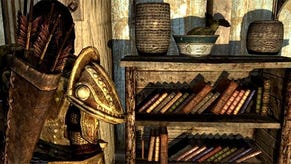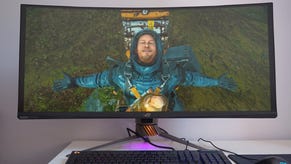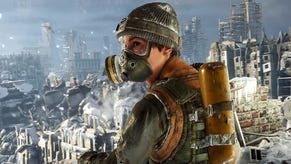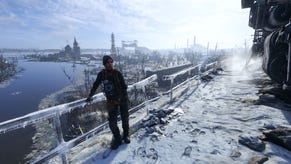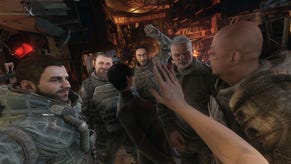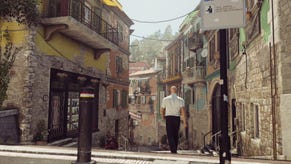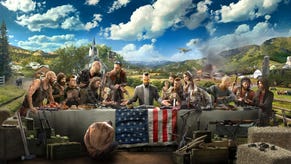Metro Exodus is a far cry from the tunnel shooter we knew
But is it Artyom
I didn't realise how much I'd missed Metro's ball bearing rifle till I spent two hours with Metro Exodus, the third in 4A Games' cult series of post-Soviet, post-apocalyptic shooters. Goodness, that rifle. The sheer delight of cranking its Super Soaker handle. The vicious snap of escaping air when you pull the trigger. The rush to make the most of those few seconds of maximum pressure, and the panic when you empty the cylinder and all your shots start to bounce off. There's no better advertisement for Metro's raw-knuckled survivalist ethic and love of analog technology. It's something I've held onto, as 4A's flight from Moscow's tunnels has exposed it to the slings, arrows, repetitions and inelegances of an open world.
Exodus is, as publisher Deep Silver's head of communications Huw Benyon is at pains to stress, more open worldy than open world. Five years in development, and apparently boasting double the playtime of its predecessors, it's a series of huge maps from various biomes, each subject to a day-night cycle and made up of "bespoke, hand-crafted" structures and scenarios. There's plenty to wrangle with, from pockets of radiation through reality-distorting anomalies to lurking crab monsters, but busywork in the Ubisoft vein is, Benyon promises, minimal to non-existent. The idea is to "give players more freedom while retaining the sense of narrative urgency" offered by the previous games, which took their cues from Half-Life: every quest you'll undertake is a story, however tangential, and every blistered edifice you'll visit is designed to imply one.
Protagonist Artyom and the other denizens of the Moscow underground are on their way westward in a wonderful old rustbucket of a train, a mobile base you'll bolt carriages and other unspecified fittings to as you tunnel through the continent. The train sums up the game's attempt to widen its horizons without softening its narrative thrust: every map, however vast, is built around one and the same railroad, and the critical path through these maps is generally dealing with some obstacle so that your party can move on. The map I'm shown is an icy flooded city, skeletal parking blocks, downed passenger jets and silent power plants jutting from dead earth and troublingly opaque water. Artyom and the Moscow refugees make an unplanned stop here when we crash into a makeshift barricade, busting the train's engine. Amid the ensuing tantrums, he and his wife Anna slip out to investigate the waving of a white flag atop a distant sunken church.
Rather than the hoped-for nice vicar with a tin of chocolate digestives, the church turns out to be home to a community of violent technophobes who worship something called the Tsar-Fish. With Anna providing cover from a nearby tower, I enter the multiple-story building using a rowboat, overhear a sermon about the infernal wiles of electricity and am promptly set upon. The writing and scripting aren't dazzling at this stage – think guards who yell state-signalling phrases like "HAVE YOU SEEN THE HERETIC" as they obligingly turn their backs on you – but the building harbours a few surprises, from dangling noise traps to a strange group of captives who wave me away with a hushed imprecation.
In the space of 15 minutes, I flatten a few believers, steal some choice gun parts, free a mother and child from the church's belltower and escape in another boat, which is then eaten by a giant amphibious terror. Hauling myself up onto the shore, I run into an ally who tacitly scores me on my performance in the church with some context-sensitive dialogue, before ushering me towards a crashed airplane that houses the first of the map's crafting tables. It's at once an introduction to the new open format and a reintroduction to the series' core principles of stealth, claustrophobia and cautious improvisation - one that just about makes the case that this is the same Metro, for all its grander prospects.
The "crazed Luddite" theme is old hat for post-apocalyptic fiction, but it does intriguingly echo Metro's own, on-going disdain for UI elements and other interfacial abstractions that might wreck the sense of inhabiting a physical body in a lovingly textured environment. There are no waypoints or enemy position indicators, just landmarks and a compass strapped (once you've found it) to the inside of your wrist. The map is an actual in-game piece of paper, though your position is magically marked upon it. "We don't give you a HUD unless it's strictly necessary," comments Benyon. "We try to convey a lot through in-game materials."
The same thinking underwrites the game's careful cherrypicking of structural elements and systems from mainstream open world titles. There are no fast travel points, but there are safehouses with beds for health recovery and crafting stations – lamplit nooks in shipping crates or upended train carriages, some equipped with ziplines that launch you straight into an activity. There's no shopping list of outposts to flip or map-revealing towers to climb, but you'll encounter clumps of more generic foes like bandits, holed up to create smallscale combat puzzles not lightyears away from the Far Cry series. One of these sees me scaling a rusty gas station from the rear, boshing a sentry and using his rifle to knock out the guards in front. It's a setup that could be from one of any number of open world shooters, though an amusing cassette recorder message inside the building lends my victims a certain personality in hindsight.
"It's important that people understand that we're not copying another game, another style – really it's about creating this hybrid," Benyon tells me. "It still has to feel like a Metro game at its heart. I think the real challenge was the initial prototype. We spent a long time learning how to mix that Metro immersion and pacing with more freedom, and make the two play nicely together." In his opening presentation, he suggests that Exodus is as much a return to STALKER, the game many of 4A's staff cut their teeth on, as a move into new territory. Naturally, I ask for his thoughts on the recently announced STALKER sequel. Benyon is sanguine. "This game is not STALKER - STALKER is an inspiration. It's going to scratch that itch for some people, but I like to think we're our own thing. I can't speak for the rest of the team, but personally I'm excited that there's a STALKER sequel coming."
The GSC Game World influence is certainly felt in Exodus's glut of crafting and customisation options. There are five parts to every gun - a scope, a barrel, a magazine, an attachment and a stock - and each gun type can take many shapes, from a wide-angle close-quarters handcannon to a silenced automatic rifle with a laser sight. The weapons you find can be stripped of parts in the field, but you'll need to visit a safehouse to apply them. While out and about you can also slap down your backpack to cobble together necessities such as bandages, ammo for "special" weapons like the ball bearing rifle and throwables such as Molotov cocktails, but you can't whip up bullets and shells. It seems a decent compromise between letting you sustain yourself on the go and ensuring that you'll eventually end up in dire straits, with nothing but knives and lint to protect you against threats like the prowling lupine Watchmen. Among the casualties of the beefed-up crafting focus are traders and thus, the previous games' usage of ammo as currency. This never came to much in practice, but it was a deft entwining of backstory and the needs of the moment I'd have liked 4A to expand upon.
Another casualty of Metro's expanded canvas is, inevitably, a certain level of direction and consistency. As in Bethesda RPGs, NPCs (including mission givers) have a way of talking over each other that eventually makes you want to shiv the lot of 'em. Some bits of dialogue also betray uncertainty about when you'll hear them – the child I rescued from the church had already taken to calling me "uncle", moments later, though this might just be an instance of bad writing. I also ran into a handful of pretty spectacular bugs, like a winged mutant that got stuck in an endless dive, sliding around on its face like a hockey puck and barging into me passive-aggressively. The same beast redeemed itself later when it startled me atop a barn, scooping me up like a disobedient kitten as I fired at vagrants through gaps in the corrugated roof. The game's newfound capacity to surprise is worthwhile but the old tunnel environments and their tighter scripting are, at times, keenly missed.
In general, I'm not quite convinced that Metro really needs this kind of breadth. I can see why it makes sense creatively and as a business proposition - as Benyon puts it, "there's only so many times you can do tunnels beneath a frozen wasteland". But the obvious concern is that it will only dilute what the first two games did well, that all of the additions will prove content for content's sake, and the blend of approaches will prove more of a skilled compromise than an advance. Such misgivings aside, there is plenty here to enjoy, whether you're new to the series or not. Metro remains a thrilling blend of sim elements and run-and-gun, steeped in Soviet and Russian aesthetic traditions rather than the kitsch Americana stylings of far too many post-nuclear games. It's still a treacherous, tentative experience, like tip-toeing over broken glass in the vicinity of a crocodile. And it still has that awesome ball bearing rifle.
Metro Exodus is due for release on February 22nd, 2019.
Check out our E3 2018 tag for more announcements, trailers, news, and goodness knows what else.






